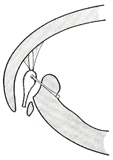|
Neothyris lenticularis (Deshayes, 1839)
Type locality: Foveaux Strait (Southern New Zealand)
Depth range: 0 - 1210 m
Terebratula gaudichaudii Gray, 1833 (not Blainville, 1828)
Terebratula lenticularis Deshayes 1839 (p. 359)
Waldheimia lenticularis Gray, 1853
Neothyris lenticularis Douvillé, 1879
Magellania lenticularis Suter, 1911
Magellania (Neothyris) lenticularis Dall, 1921
Neothyris obtusa Thomson, 1920
Neothyris lenticularis compressa Naell, 1972
Neothyris dawsoni Neall, 1972
Neothyris parva Cooper, 1982
? Neothyris compressa Foster, 1989
Diagnose in preparation -

Fac-simile of the original description by Deshayes (1839).
Should be added:
Muscle disposition: see Fig. in front - close proximity between the main and the accessory adductor muscles bases on the ventral side
|

Disposition of the pedicle and pedicles muscles - sagittal section
(from Richardson, 1979)

Muscle attachment (modified, from Richardson, 1979; and
from Foster, 1974 -
with absence of separate posterior accessory diductor muscles base, the pair of ventral adductor muscle bases in &a single unit, and dorsal, and the dorsal pedicle adjustor muscle bases not located at the anterior edge of the hinge plate)
|




